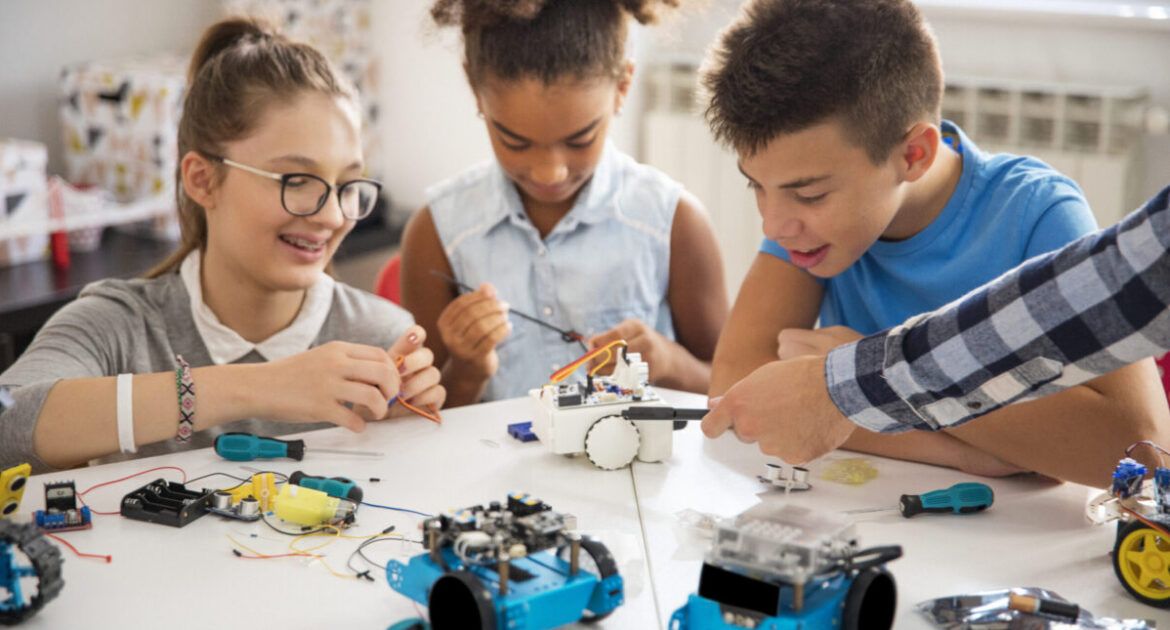As an engineering professor, I am passionate about STEM skills and STEM education. STEM Day 2023 is an important day for me, and I would like to invite you to celebrate all aspects of STEM with me today.
On STEM Day, we have an incredible opportunity to inspire and empower the next generation of innovators. It’s a day for children to dive headfirst into the fascinating world of STEM. We’re not just talking theory here; we’re talking hands-on experience for kids: from building robots to using coding apps and visiting laboratories and field sites.
The impact of STEM fields on society cannot be overstated. It’s not just about equations and algorithms; it’s about designing solutions that will make our lives on this planet better. STEM students are our future leaders who will tackle the challenges of tomorrow in a world with a less stable climate and in which artificial intelligence will become much more important.
Faculty as STEM ambassadors
Can you think of any better way for us as faculty members to share our love for what we do with the next generation? But of course, the reality of our day-to-day jobs as professors is that we are quite busy with our teaching, research and service. So, let me invite you to carve some time out of your busy schedule to reach out to young minds. If you are still doubting, here are a few reasons why you should consider passing on your love for STEM to children:
- Nurturing future innovators: It’s never too early to plant the seed of interest and curiosity in the next generation of students and future leaders. It is also important that we think about the skills our future innovators need to learn, ideally early on.
- Creating lifelong learners: Once we teach children how to learn STEM skills, they will know where and how to look for further developing their skills. In today’s knowledge-based society, being able to identify what to learn, and how to pick up the skill is almost as important as acquiring the skill itself.
- Expanding diversity in STEM: If we look at today’s professors in STEM, we see less diversity than in our current student body, and again less diversity than in the demographics of today’s society. Reaching out to younger children is a good way to reach a more diverse group of learners. Tomorrow’s leaders will be more diverse than ever.
- Highlighting the broad issues STEM addresses: STEM studies and jobs may have a bad reputation of being “boring”. There is the pervasive cliché of the nerd crunching numbers behind the computer all day long. In reality, those of us who work in STEM have dynamic jobs, in which we meet people from all backgrounds, collaborate across fields, and work on technological solutions for a wide range of societal challenges.
Activities to inspire young minds
Now that I have convinced you why spending time teaching young children about STEM is important, your next question may be: “What can I do?”. Depending on the age of the students, there is a wide variety of activities you can think of developing together with teachers at a local school:
- Shadowing a STEM professional: For students to understand what a day in the life of a STEM professional looks like, there is no better way than being able to shadow a professional for a day. For example, if a student gets to shadow a bridge engineer, they may learn about how dynamic this field is: from meeting with clients, and catching up on recent research insights, to putting on steel-toed boots to stop by the job site.
- Introduction to coding: Programming is an essential STEM skill, but unfortunately there are still a lot of prejudices about who can and who cannot code. You can consider organizing a fun workshop or hackathon to introduce children to programming, for example through the didactic language Hedy.
- Lego robotics: Robotics with Lego, combined with programming, is a classic STEM-celebrating activity, and for good reasons. I remember falling in love with the combination of hands-on building a Lego vehicle representing the Mars rover and the problem-solving involved with programming the vehicle when I was a teenager, and I think many kids nowadays will still enjoy this activity as much as I did decades ago.
- STEM art: STEM fields are inherently creative, as problem-solving requires a lot of creativity. To take the creative aspect up a notch, you can prepare an activity that combines STEM and art. From using principles of acoustics and vibrations to draw patterns with sand to creating STEM-based art with 3D printing, there are many options for combining STEM and art in engaging ways.
- Outdoor explorations: STEM activities are not just bound to classrooms and laboratories. You can think about outdoor activities directly related to STEM applications, such as going to a nearby river or lake to test the water quality and learn about environmental engineering, or by going into nature to observe principles of mathematics and physics outside (such as Fibonacci’s series in a Romanesco broccoli).
- Virtual reality adventures: Many museums nowadays already have virtual reality and augmented reality as part of their exhibitions. You can use similar techniques to immerse kids into fascinating environments, such as outer space or the deepest parts of the ocean. These experiences can trigger a desire to learn more about the natural world and drive the wish to understand the world around us at a deeper level.
Conclusion
STEM Day 2023 is an excellent opportunity to share our love for STEM skills and education with young minds who will be our future leaders. Let’s celebrate by inspiring the next generation of scientists, engineers, artists, leaders, and innovators. I shared with you why you should consider organizing an activity to celebrate STEM Day 2023, and I gave you a few first ideas on the types of activities you may want to organise, I hope you will have a blast on STEM Day 2023!
Related Article:





Hi Eva – please could you tell me, why STEM and not STEAM?
Best wishes
Jackie